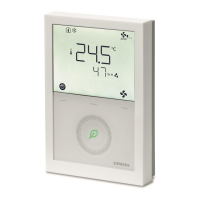4.12.3 LTE-Mode
LTE-Mode was specifically designed to simplify engineering. Unlike with S-Mode,
individual connections (group addresses) need not be created in the tool. The
devices autonomously establish connections.
The following circumstances are predefined:
● Every device or subdevice is located within a zone
● Every data point (input or output) is assigned to a zone
● Every data point (input or output) has a precisely defined "name"
Whenever an output and an input with the same "name" are located in the same
zone, a connection is established automatically, as shown in the following diagram.
● For a detailed description of KNX (topology, bus supply, function and setting of
LTE zones, filter tables, etc.), see "Communication via the KNX bus for Synco
700, 900 and RXB/RXL, Basic Documentation [➙ 5]" [7]
● LTE-Mode data points and settings are described in the Synco Application
Manual [➙ 5] [14]
● To engineer and commission a specific system, use the Synco700 planning
and commissioning protocol [➙ 5] (XLS table in HIT, [8])
4.12.4 Zone addressing in LTE-Mode (with Synco)
Zone addresses must be allocated where RDG2..KN KNX room thermostats are
used in LTE-Mode (e.g. in conjunction with Synco).
The following zone addresses must be defined together with the Synco devices at
the planning stage based on application.
● "Subzone" of "Geographical zone" is fixed at 1 (not adjustable).
The device sends and receives LTE communication signals only, if the zone
address is valid (not OSV = not out of service).
● Both geographical zones P901 and P902 cannot be set to same value on two
devices simultaneously.
The zones are defined as follows:

